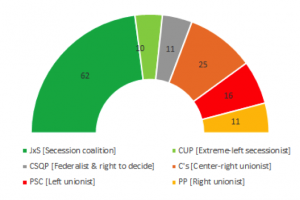By Marc Guinjoan
The former Catalan PM, Artur Mas (left), shaking hands with the newly elected PM Carles Puigdemont (right) in the Parliament on Sunday.
The last Catalan regional elections took place on September 27th 2015. The Catalan government, led by Prime Minister Artur Mas of the center-right nationalist Convergència i Unió (CiU), called early elections after having been unable to convince the Spanish government to hold a referendum on secession in Catalonia. Before the elections took place, the coalition composed of CiU and Convergència Democràtica de Catalunya (CDC) was dissolved. The main (pro-secession) faction within CiU formed an electoral coalition (joint list) with the left-wing secessionist party Esquerra Republicana de Catalunya (ERC). The joint list was called Junts pel Sí (JxS, Together for the Yes).
JxS won the September 27th elections, with 62 deputies elected out of 135. The extreme left-wing secessionist Candidatura d’Unitat Popular (CUP) managed to have 10 deputies elected. Together the secessionist parties had 72 deputies, and thus a majority of seats, against 63 for the anti-secessionist parties, as shown in the graph below.
In order to be re-elected PM, Artur Mas could count on the support of the 62 deputies elected under the JxS list, and on the opposition of the 63 deputies from the anti-secessionist parties. This means that he also needed some support from the extreme left secessionist CUP. But during the campaign the CUP had promised not to support Artur Mas because of his austerity measures. So the question was whether Mas, or someone else, could obtain majority support or not. The parties had until January 10 to come to a deal. According to the Constitution, new elections would be automatically called if no candidate had managed to get majority support by that date.
The negotiations between JxS and the CUP lasted several months, and appeared to have ended in a deadlock. After several CUP activist assemblies, including a 1515 vs 1515 vote draw in a massive assembly, the CUP finally announced that it would not support Mas, on January 3, one week before the deadline. The party indicated that it was willing to join the secessionist coalition only if JxS came up with another candidate. As the JxS reiterated its support for Mas, everyone was getting prepared for a new election.
And then, at the very last minute, Artur Mas announced that he had decided not to run as PM, and proposed a new candidate from CDC, Carles Puigdemont, the (now former) mayor of Girona. In short the CDC accepted the condition imposed by the extreme left-wing CUP. In return CUP allowed two of its deputies to vote for Carles Puigdemont (and the other eight abstained). That vote, which occurred just two hours before the deadline, led to the election of Puigdemont as PM and the formation of a secessionist government in Catalonia.
In short the small CUP, with only 10 deputies, eventually managed to impose its condition to the JxS, with 62 deputies. CUP was successful because JxS was concerned that the possibility of not electing a president in an election labelled as a “plebiscite” on Catalan independence would lead to frustration among its supporters. Additionally, although JxS would have probably obtained similar results if new elections had been held, CUP would probably have lost ground, thus complicating the achievement of a majority in favour of secession. In sum, Mas’ last minute resignation allowed CDC to continue holding the position of PM in Catalonia, and represented a powerful but exclusively symbolic gain for the CUP, since there is no indication that the new PM is more leftist than the one who was forced to resign. It remains to be seen who are the long-term winners and losers.

